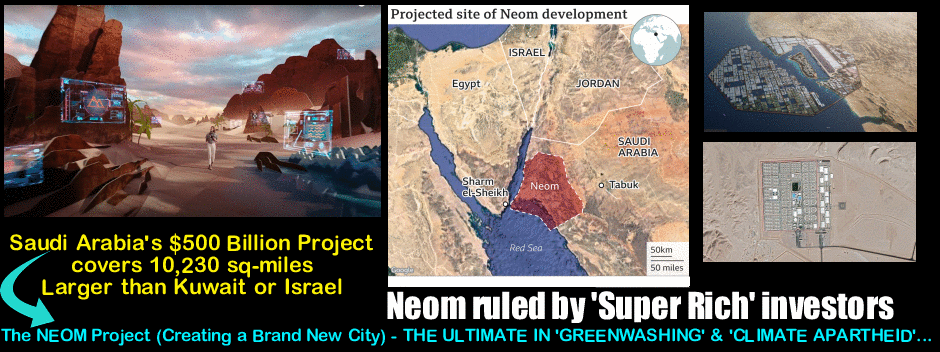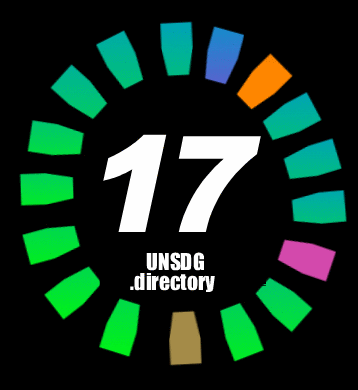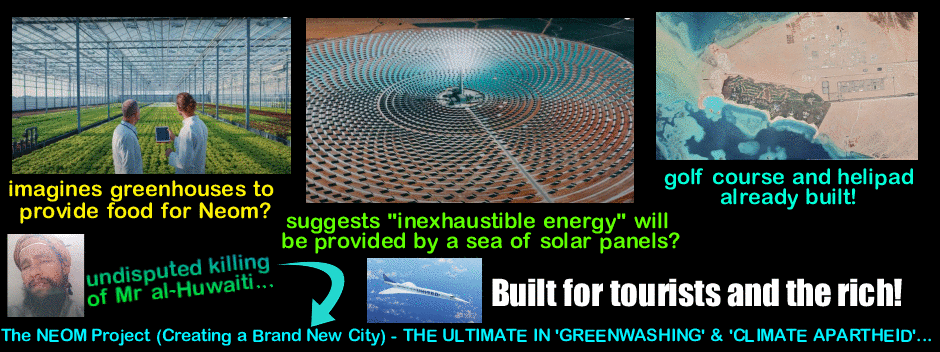Neom: a planned eco-city in the Saudi desert?

Hello fellow environmentalist / equality champion,
The NEOM Project (Creating a New City): THE ULTIMATE IN ‘GREENWASHING’ & ‘CLIMATE APARTHEID’…THE FACTS: Neom is a $500bn (*£366bn) project, part of Saudi Arabia’s Vision 2030 plan to wean the country off oil (but they’re still going to continue selling 10 million barrels of the black ‘stuff’ each & every day!).
A Neom ad promises the city will be like a playground
Glow-in-the dark beaches. Billions of trees planted in a country dominated by the desert. Levitating trains. A fake moon. A car-free, carbon-free city built in a straight line over 100 miles long in the desert. These are some of the plans for Neom – a futuristic eco-city that is part of Saudi Arabia’s pivot to go green. But is it all too good to be true?
Neom claims to be a “blueprint for tomorrow in which humanity progresses without compromise to the health of the planet”. It’s a $500bn (£366bn) project, part of Saudi Arabia’s Vision 2030 plan to wean the country off oil – the industry that made it rich.

Choose Your UNSDG listing package.
Covering a total area of over 26,500 sq-km (10,230 sq-miles) – larger than Kuwait or Israel – Neom will, developers claim, exist entirely outside the confines of the current Saudi judicial system, governed by an autonomous legal system that will be drafted up by investors.
Ali Shihabi, a former banker now on Neom’s advisory board, says the mega-territory will include a 170km (105m) long city, called The Line, which will run in a straight line through the desert.
If that sounds unlikely, Shihabi explains that The Line will be built in stages, block by block. “People say this is some crazy project that’s going to cost gazillions, but it’s going to be built module by module, in a manner that meets demand,” he says.
Much like Barcelona’s traffic-free “superblocks”, he explains that each square will be self-sufficient and contain amenities such as shops and schools so that anything people need will be a five-minute walk or cycle away.
When complete, travel along The Line will be via hyper-speed trains, with the longest journey “never more than 20 minutes”, the developers claim.
What’s more, Neom will be home to Oxagon, a city floating on water spanning 7km (4.3 miles) – making it the largest floating structure in the world. Neom’s chief executive, Nadhmi al-Nasr, has said the port city will “welcome its first manufacturing tenants at the beginning of 2022”.
The floating industrial hub Oxagon is just one of the planned components of Neom.
Further up the Red Sea coast from this “industrial hub”, Neom has announced plans for the world’s largest coral reef restoration project. Its website, which sometimes sounds like something out of a sci-fi novel, claims that the first phase of the mega-territory will be completed by 2025.
That’s the vision. The reality, for now, is more modest.
A satellite image currently shows that a single square of The Line has been built. As well as rows of homes, it has two swimming pools and a football pitch.
But how feasible is it to build a cutting-edge city that lives up to its green credentials in the middle of the desert?
Dr Manal Shehabi, an energy expert at the University of Oxford, says that when evaluating how sustainable Neom can be, there are many things to consider. Will food be produced locally in a system that doesn’t use an excessive amount of resources or will it rely on food imports from abroad?
The website claims that Neom will become “the world’s most food self-sufficient city”. It sets out a vision for vertical farming and greenhouses – revolutionary for a country that currently imports about 80% of its food. There are questions about whether this can be done sustainably.
Blog continues here…(part 2)
Enjoy your day on this wonderful planet!

Choose Your UNSDG listing package.


